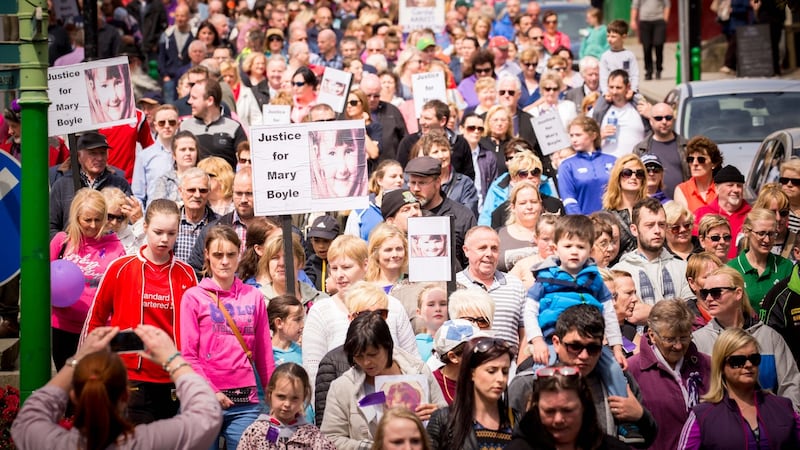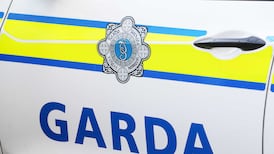The lead investigator into the disappearance in 1977 of Mary Boyle, Ireland's longest-running missing person case, believes a breakthrough could have been made if modern policing methods had been available at the time.
Former Det Sgt Aidan Murray said the scene of the disappearance would today have been sealed off immediately whereas, nearly 40 years ago, people trampled over potential evidence.
Six-year-old Mary vanished without trace when walking through fields while visiting her grandparents.


It is now believed likely she was killed on the day she vanished, March 18th, 1977. Nothing she wore was ever found, including her Wellingtons and her distinctive hair-ribbons, nor was a Tayto bag she carried.
Murray, who was scenes of crime officer in south Donegal where she went missing, was a leading investigator of several paramilitary crimes at a time of heavy IRA activity in the area.
Searches for Mary over several days in a townland adjacent to the Border took place at a time when Garda districts there had up to five or six times their usual personnel.
Suspected murder
Many gardaí were diverted to the hunt for Mary when the girl disappeared at Cashelard, outside Ballyshannon.
They and civilian searchers ploughed across ground that would today have been immediately sealed off to protect the scene of the disappearance.
Murray recalled that for several days the search was for a missing girl, and not a suspected murder as he now believes happened.
“With a child lost a lot of people would have been trampling with Wellingtons on them,” he said. “There would be about 20 or 30 guards and they would tramp over everything. By the time I got up the scene wouldn’t have been preserved. It would have been interfered with, a number of guards doing their duty searching for some kind of an indication of where the child went.”
He said that with local and visiting gardaí and civilians in the search there would have been up to 200 or 300 people “trampling” all over the area.
“It would have been sealed off immediately if it was now they had to do it,” he said. “It would have been sealed off until people from Dublin came down and examined it for minute evidence.”
Murray was speaking amid renewed interest in the case, fuelled by a claim in a documentary, Mary Boyle: The Untold Story, produced by journalist Gemma O'Doherty, that a politician phoned Ballyshannon Garda station to demand that a small group of people close to Mary weren't to be listed as suspects.
Murray recalls a rumour about a call which he heard about at a later Garda conference. His colleague, Sgt Martin Collins, says the call was from a politician who he hasn't named.
Both retired sergeants have emphasised the call was immediately dismissed and no senior officer interfered with their investigation as a result of the message.
Murray, who was interviewing the main suspect as a witness around the time the call was made, has told The Irish Times he was advised by an inspector to ease his questioning and fetch a glass of water for the man.
Mental instability
Murray said the instruction to ease up was given because of a history of mental instability in the suspect’s extended family.
At one stage in the interview, when it was suggested that Mary may be dead, the suspect “lost the head a wee bit”, said Murray. The suspect accused the detective of wrongly blaming him for anything that may have happened to the girl.
Murray said the inspector’s fear was that if the suspect was pushed too far, he might have taken his own life.
Murray and Collins feature prominently in the YouTube documentary. Both have rejected the assertion in the documentary of a Garda cover-up over political interference, leading to no one being arrested as a suspect for Mary’s disappearance.
Murray, who did say in the documentary that as a result of the phone call to the Garda station that the “ease off” instruction was delivered, now says because they were still investigating a case of a missing child, not a dead child where there was no body, the instruction was that nobody could be arrested for murder.
“If there’s any cover-up, it’s not within the gardaí,” he said.
He said if there was a cover-up it was in a small group of people linked to the Cashelard area.
“Everybody felt that they closed ranks on us. Somebody up there knows more than they are saying,” said Murray.
Collins conducted a five-hour interview with Mary Boyle’s mother Ann at the same time as Murray was interviewing the main suspect as a witness in another room.
Collins said: “We spoke with her, laughed with her, cried with her. It was a very emotional interview because we all had youngsters the same age. It was a tough interview for us to carry out.”
Both retired sergeants have agreed with Mary's twin sister, Ann Doherty, that the child may have been killed because she was about to reveal that she had been sexually assaulted.
Collins emphatically rejects that gardaí were covering up political interference in the case.
He said a call was made to the station, the gist of it being that none of a small group of people linked to the Cashelard area was to be made a suspect.
The call was taken by a station orderly and directed to one of the offices down the corridor.
“All I know is that the name of a politician was mentioned. I didn’t hear the phone call,” Collins said.
“It was common knowledge about this phone call, but it was treated with the utmost negativity and it had nothing whatsoever to do with the investigation.”
He agreed it may have been also common knowledge which politician made the call.
Specified name
He wouldn’t confirm a specified name: “The whole thing should be about the missing child Mary Boyle. The cover-up, the punch-line as I call it, of a cover-up and Garda influence, that has taken away, in my view, from the most serious matter which is Mary’s disappearance.
“If there is a cover-up, it’s certainly not within the Garda Síochána and it’s certainly not influenced by any politician.
“There are persons – and I have even said it in the documentary – there are persons out there who are withholding vital information and it’s now time after 40 years for those people to come forward with that information. It’s only a small cohort of persons.”
Murray earlier this month made a sworn affidavit to Ballyshannon-based solicitors Reid & Sweeney, run by John Murray who is no relation but who is son of the late Supt Dominic Murray who was senior officer in the Mary Boyle investigation.
Aidan Murray said in his statement: “The comments made regarding an alleged phone call made to Ballyshannon Garda station by a local politician were based on rumours only. I was not aware of any alleged phone call at the time and I subsequently heard the rumour many months later at a Garda conference.”
While the two retired officers willingly gave of their time to help make the documentary, there is now a division between them and O’Doherty about how it was edited.
Murray said: “There were things I said that weren’t in the documentary.
“I am definite that no political influence was used in the inquiry; the inspector was genuinely fearful that the suspect could harm himself if we pushed him too far in what was a witness interview.”
Collins said: “The documentary included some of what I said and didn’t include other parts of my interview. There were 20 or 30 other investigators but as far as I am concerned there was no pressure whatsoever on my part of the investigation.”
Solicitor John Murray, who was a student when Mary Boyle vanished, said he was anxious to establish the truth when he saw the documentary that suggested his father, Supt Murray, the lead Garda officer in south Co Donegal, obstructed the investigation.
He told The Irish Times: "It is important to me and my family that the truth of the allegation being made against him is established. We wanted to know the truth good or bad."
As a result he contacted Collins and Murray. He said they “emphatically” told him that his father did not interfere or hinder the investigation in any way.
“Now, because my father is deceased we have to endure the most cruel and heartless comments on social media which is wholly unregulated and suitable for this,” he said.
Gemma O'Doherty refused to comment to The Irish Times. However, she said on local radio station Ocean FM this week that she was not retracting anything in the documentary and that Aidan Murray and Martin Collins expressed "profound happiness" about the documentary when it was first aired on July 4th.
O’Doherty’s documentary has received prizes in the Hollywood International Independent Documentary July 2016 Awards.
There is widespread speculation that the politician who made the phone call is Sean McEniff, who has been a councillor on Donegal County Council and Bundoran Town Council for 55 years.
Speculation
He acknowledged to The Irish Times that he was at the centre of the speculation but rejected absolutely that he made any phone call. He insisted if he wanted to call the superintendent at the time, he would have phoned his direct line and not gone through a station switchboard.
Mr McEniff said: “I would never be involved in that nor would I ever be involved in it. That’s what you call corruption of the highest order.”
Mary vanished when she followed her uncle Gerry Gallagher about 400 metres across boggy fields to a neighbour's house when he was returning a ladder sometime between 3.45pm and 4.20pm that day.
Gallagher told gardaí that when they were about 60 yards from the neighbour’s house Mary turned to return home. That was the last time she was seen.
After a family search, gardaí were notified about two hours after the disappearance.
Collins said what happened to Mary was a mystery. “There is a time-span there, the time she went missing and the time it was reported to the gardaí. It’s a vital time,” he said.
A Garda cold case review continues into the disappearance.









